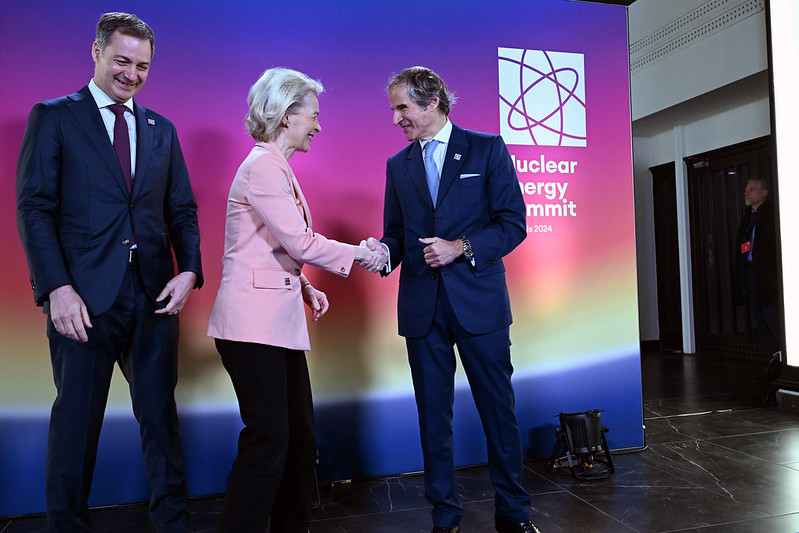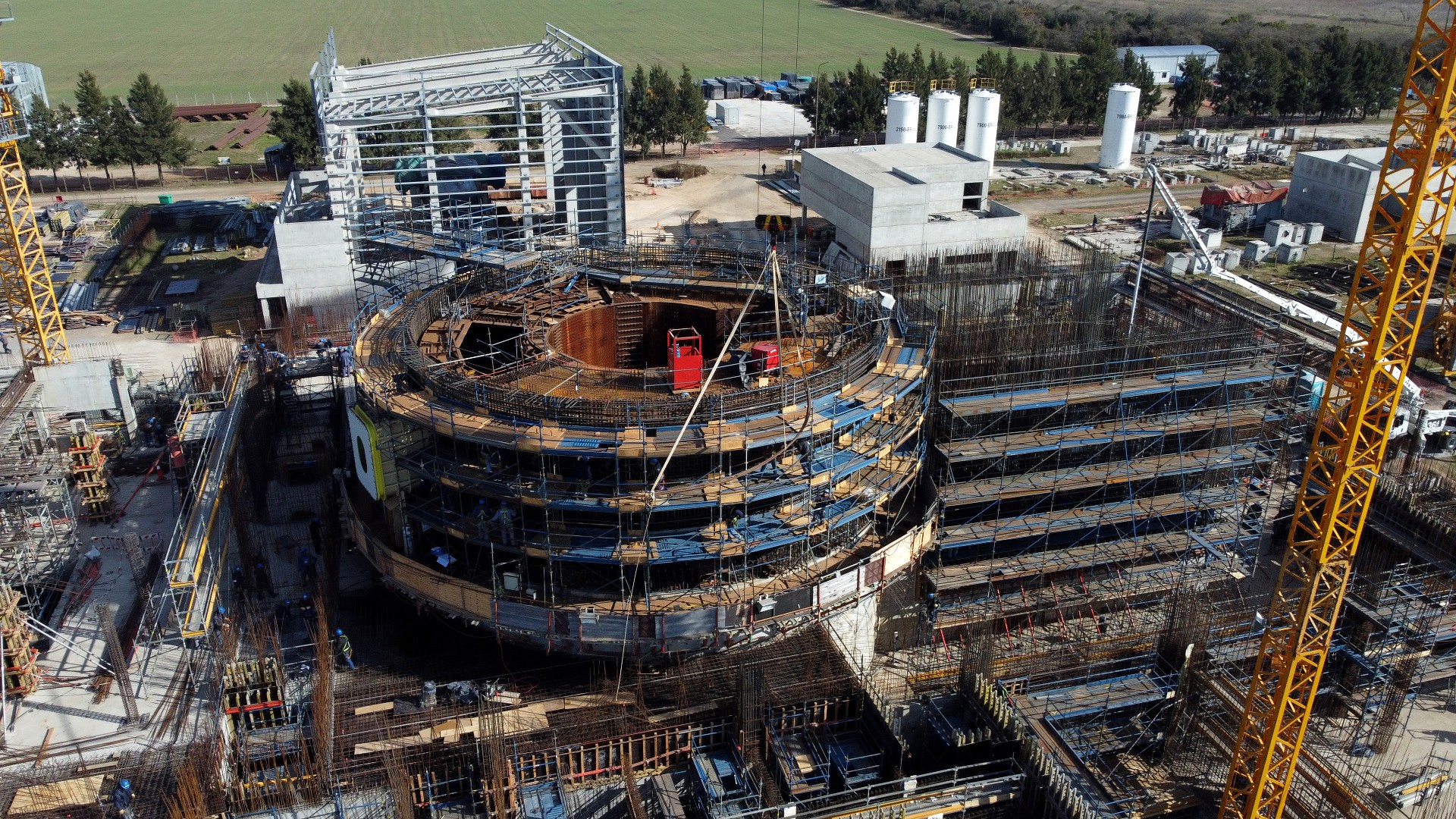

“Nuclear energy is a reliable and dispatchable zero emission source of electricity generation and a firm backbone for clean energy systems to keep them resilient and sustainable,” stated the Declaration on Nuclear Energy adopted at the Nuclear Energy Summit, held on March 21.
Belgian Prime Minister Alexander De Croo said the challenges of climate change will require “vast, safe, and reliable amounts of carbon-neutral energy,” and nuclear energy must be part of the mix.
“Energy abundance is the way forward,” he said. Belgium is planning to quadruple its offshore wind production by 2030, he said, but it is also extending the operations of its youngest nuclear power plants and investing in research into small modular nuclear reactors.
“Nuclear and renewables go hand in hand,” he said.
The first-of-its-kind summit was co-chaired by De Croo and Rafael Mariano Grossi, Director General of the International Atomic Energy Agency (IAEA). It brought together heads of government and other high-level representatives from more than 30 countries that have nuclear power plants or are exploring that source of energy, along with more than 300 industry CEOs, entrepreneurs, scientists, and leaders of nongovernmental organizations.

Belgian Prime Minister Alexander De Croo (left) and Rafael Mariano Grossi of the International Atomic Energy Agency, welcomed European Commission President Ursula von der Leyen when she arrived for the recent Nuclear Energy Summit.
The gathering in Brussels came on the heels of COP28—the most recent United Nations Climate Change Conference—held at the end of last year in Dubai, United Arab Emirates. (The COP acronym refers to the Conference of the Parties to the United Nations Framework Convention on Climate Change.)
At a joint press conference in Brussels, De Croo and Grossi said that COP28 marked a turning point in the debate about nuclear energy, which they said had tended to be more ideological than scientific over the years. The consensus document adopted at the close of COP28 included nuclear among the zero- and low-emission technologies that should be accelerated; the others listed were renewables, abatement and removal technologies, and low-carbon hydrogen production.
COP28 marked “the first time that it was really clear that nuclear is part of the solution,” De Croo said. “It is not the solution, but it is part of the solution to fight climate change.”
The IAEA’s Grossi said that at some previous COPs, he had sensed that nuclear was not welcome, but COP28 was different. “Now, I think there is a convergence,” he said in Brussels. “There is an idea that there is a bigger problem that we need to deal with.”
Many countries around the world are developing or exploring the potential use of small modular reactors (SMRs).
In Dubai, 25 countries—including the United States, Canada, and Jamaica—signed on to a declaration that set a goal of tripling the world’s nuclear energy capacity by 2050 to support decarbonization. Jamaica does not yet have nuclear power plants, but Prime Minister Andrew Holness has spoken publicly about the need to explore new nuclear technologies such as small modular reactors.
Among the Latin American countries, Argentina, Brazil, and Mexico include nuclear power in their energy mix.

Scientists research radioactive materials at the Idaho National Laboratory Hot Fuel Examination Facility in the northwestern United States.
One country ramping up investment in nuclear energy these days is the United States. John Podesta, who was appointed earlier this year to lead the Biden administration’s global climate efforts, said at the recent Nuclear Energy Summit that the U.S. would need to build 200 gigawatts of new nuclear capacity domestically to meet its commitment to reach net zero by 2050.
“We’re getting to work,” Podesta said. He cited recently adopted legislation that allocated $2.7 billion to restart the U.S. nuclear enrichment program, as well as incentives for nuclear power included in the 2022 Inflation Reduction Act. The U.S. Export-Import Bank also has financial tools to support global deployment of small modular reactors, he said.
Canada is also investing in domestic nuclear power, providing export financing, and entering into fuel supply agreements, according to the country’s Ambassador for Climate Change, Catherine Stewart.
“As home of some of the most sustainable and reliable uranium deposits in the world, Canada remains steadfast in our commitment to forging more reliable uranium supply chains for global partners,” she said in Brussels. In this way, she said, Canada is supporting Europe’s efforts to become less energy-dependent on Russian President Vladimir Putin’s regime.
According to the World Nuclear Association, an international organization that represents the global nuclear industry, Kazakhstan has been the leader in uranium mining production over the past decade, accounting for 43% of the world supply from mines in 2022. Canada was next (15%), followed by Namibia, Australia, Uzbekistan, and Russia.

The Cruas nuclear power plant, on the Rhône River, is one of dozens of reactors in France, which gets a larger share of its electricity from nuclear power than any other country.
France gets a larger share of electricity from nuclear power (62.5% in 2022) than any other country, according to the World Nuclear Association. Although the United States generates the largest quantity of nuclear electricity, nuclear accounts for a smaller percentage of the electricity mix (18.2%) than in many other countries. Nuclear energy also makes up a relatively small percentage of the electricity generated elsewhere in the Americas: 12.9% in Canada, 5.4% in Argentina, 4.5% in Mexico, and 2.5% in Brazil.
In Brussels, Jorge Jesús Antelo, Argentina’s National Strategy Secretary, said that nuclear energy has a role to play in the energy transition, energy security, and economic development. “Argentina is a country in expansion when it comes to nuclear energy,” he said.
In Brazil, “nuclear energy has a complementary role in the country’s electrical grids,” the President of the National Nuclear Energy Commission, Francisco Rondinelli, told participants at the summit. “This means that nuclear energy is a strategic source for complete and stabilized distribution through the huge Brazilian electrical system,” he added.

Protesters warn of the risks to the Zaporizhzhia power plant in Ukraine due the Russian invasion.
Despite the renewed interest in nuclear energy, the sector continues to face steep challenges. The triple meltdown at the Fukushima Daiichi power plant in Japan in 2011 reminded the world of the dire consequences of a major nuclear accident, as had previous accidents at the Three Mile Island plant in the United States (1979) and Chernobyl (1986) in what is now Ukraine.
Since the Russian invasion of Ukraine, there have been multiple attacks on Ukraine’s Zaporizhzhia nuclear power plant, the largest in Europe. “For the first time in history, a war is taking place in a country with advanced nuclear facilities and infrastructure, demonstrating a new kind of nuclear safety and security risk,” the Bulletin of the Atomic Scientists noted recently.
Beyond safety issues, the nuclear industry has often faced long timelines and major cost overruns. In a recent opinion piece in the New York Times, Stephanie Cooke—the author of the 2009 book In Mortal Hands: A Cautionary History of the Nuclear Age—criticized the efforts underway to revive the industry. She cautioned that substantial amounts of money “will be wasted on perpetuating the fantasy that nuclear energy will make a difference in a meaningful time frame to slow global warming.”
“The future of nuclear depends on the industry’s ability to deliver on time and on budget,” Ursula von der Leyen, President of the European Commission, said at the Nuclear Energy Summit. She urged countries to innovate to bring new nuclear technologies to market and also consider the possibility of extending the life of existing plants.
“Extending the safe operation of today’s nuclear fleet is one of the cheapest ways to secure clean power at scale so it can help pave a cost-effective path to net zero,” she said.

A prototype small modular reactor is under construction in Zárate, Argentina, in the northern part of Buenos Aires province.
Many countries around the world are developing or exploring the potential use of small modular reactors (SMRs).
As the name implies, these are designed to have a fraction of the physical footprint of a conventional nuclear reactor, and their modular nature makes it possible for prefabricated systems and components to be shipped to a location and then installed, according to the International Atomic Energy Agency (IAEA). The largest of these advanced reactors would be able to generate up to 300 megawatts (MW) of electricity per unit—about one-third the size of traditional reactors—while microreactors could generate up to 10 MW.
One example of SMR technology in operation: In 2020, Russia deployed the world’s first floating nuclear power plant, the Akademik Lomonosov, which produces energy from two 35 MW small modular reactors.
More than 80 SMR designs are now under development in 18 countries, according to IAEA Director General Rafael Mariano Grossi, who talked about the technology in remarks he made by video to the Sixth Ministerial Meeting of the Energy and Climate Partnership of the Americas (ECPA).
“Small modular reactors could contribute decisively to achieving climate and energy security goals,” he said. But despite the progress made, he added, deploying this technology in time to address climate change “continues to be a challenge.”
The IAEA has been convening political leaders and regulators, as well as industry representatives such as plant designers and operators, to develop shared regulatory and industrial approaches for SMRs, Grossi said. He encouraged countries to join in efforts to deploy this technology and offered IAEA support.
The agency, which is part of the United Nations family, is the world’s central intergovernmental forum for scientific and technical cooperation to promote safe, secure, and peaceful uses of nuclear science and technology. It has 178 member states, including most countries in the Americas.
The ECPA Ministerial Meeting—which took place March 14-15 in Punta Cana, Dominican Republic—included a side event on small modular reactors, which featured speakers from the IAEA, the U.S. Department of Energy, the Canadian Nuclear Association, and the private sector.
At the recent Nuclear Energy Summit in Brussels, representatives of Canada and Argentina referred to SMR projects underway in their countries: the Darlington project in the Canadian province of Ontario and the CAREM project in the province of Buenos Aires.
Jorge Jesús Antelo, Argentina’s National Strategy Secretary, noted his country’s decades of experience with nuclear energy. He said that its SMR demonstration plant is in an advanced stage of construction and that the country is exploring opportunities to export these nationally designed reactors in the future.
“This is a real, ongoing project that stands out for its characteristics of efficiency, versatility, and ease of implementation,” he said.
 View Map
View Map